How to Cite | Publication History | PlumX Article Matrix
Comparative Studies of Some New Potato Cultivars and Their Morphological Characteristics
J. Mohammadi1*, S. A. Khasmakhi-Sabet1, J. A. Olfati2, A. Dadashpour3, J. Lamei4 and B. Salehi1
1Azad University, Abhar branch, Horticultural department, Abhar Iran
2University of Guilan, Horticultural Department, Rasht Iran
3Tehran University, Horticultural department, Karaj Iran
4Zanjan University, Horticultural department, Zanjan Iran
Corresponding Author E-mail: jaf_mohammadi@yahoo.com
ABSTRACT: Potato is not an indigenous crop of Iran but both red and white skinned potatoes are commonly grown. Present study was conducted to screen few potato varieties received from national breeding program and to evaluate them for recommending the cultivation of the best selected variety. Ten varieties i.e. Finna, Kondor, Ditta, Romano, Bright, Picaso, Santa, Marfona, Bolesta and Cosmos achieved form breeding program with control Agria were tested for their vegetative and morphological characteristics under local conditions. It was found that the cultivar Finna superseded all other cultivars with regard to growth and suitable morphological characteristics. The cultivars Kondor also appeared to be promising for adoption in future.
KEYWORDS: Potato; morphological characteristics; breeding program; cultivars
Download this article as:| Copy the following to cite this article: Mohammadi J, Khasmakhi-Sabet S .A ,Olfati J. A,Dadashpour A, Lamei J, Salehi B. Comparative Studies of Some New Potato Cultivars and Their Morphological Characteristics.Biosci Biotechnol Res Asia 2010;7(1) |
| Copy the following to cite this URL: Mohammadi J, Khasmakhi-Sabet S. A ,Olfati J. A,Dadashpour A, Lamei J, Salehi B. Comparative Studies of Some New Potato Cultivars and Their Morphological Characteristics.Biosci Biotechnol Res Asia 2010;7(1). Available from: https://www.biotech-asia.org/?p=8935 |
Introduction
The potato (Solanum tuberosum L.) is an annual, cool season plant belonging to Solanaceae family. Potato is an important vegetable crop throughout the world. Potato gives higher production even than wheat and rice and at the same time its nutritional value is superior than most of the food crops. It is the richest source of carbohydrates. The potato has good nutritional value. One medium sized potato (about 1/3 pound) supplies 35% of the U.S. recommended daily allowance of Vitamin C, 6% protein, and 10% iron, as well as other vitamins and minerals, yet only has 100 calories.
Both red and white skinned potatoes are commonly grown. Other colors, including blue, pink, and yellow, are also naturally occurring, but seldom grown. Optimum yields of potatoes are achieved during a long, cool growing season. The edible portion of the plant, the tuber, is an underground modified stem structure; the “eyes” are the buds which sprout shoots.
Potato is not an indigenous crop of Iran. Since potatoes are propagated vegetatively, the seed tubers are the major source of survival of different diseases (Akius and Kloos 1990). Farmer’s practices further accelerated infection of seed stocks as they generally used smaller (Bhomi and Kloos 1991) and leftover tubers as seed.
Cultivar selection is very important for growers trying to market quality product. Estevez et al. (1982) studied the factors affecting tuber yield in eight potato cultivars. They observed that the number of tubers per plant, average tuber weight and plant height were most closely related to tuber yield. Estevez (1982) studied tuber yield of seventeen potato varieties from Canada, France, Holland and Germany. The cultivars with the heaviest tuber weight gave the best yield and had the lowest number of tubers per plant. Jablouski (1990) reported that tubers of potatoes cv. Ronda and Sowa were planted at three depths, deeper planting increased number of days to emerge but had no effect on maturity date. Ronda gave higher seed tuber yield than Sowa. Bisen and Barholia (1991) tested cultivars of potato for various parameters of growth. They found that among 8 varieties of potato, the Kufri and Joyti were the highest yielding varieties (32.5 and 29.7 tonnes/ha). Keeping in view the above factors, present project was undertaken to evaluate different potato cultivars in terms of their growth and morphological parameters.
Materials and Methods
Eleven new release cultivars obtained from different breeding program of the country (Table 1) were evaluated at the Potato Research Farm, Abhar, Azad University. Potato cultivars were planted in 3.6 m2 plot size in three replications. The soil type was a loamy-sand and rainfall was supplemented with overhead irrigation as needed. Chemical fertilizers were applied at the rate of 100:100:60 kg ha-1 NPK. Spacing was maintained at 60 cm as row to row and 25 cm as plant to plant. Observations were made and the data on morphological characteristics were recorded. Following data were recorded: number of branches per plant, plant height, days to flowering, skin color and resistant to some diseases.
In order to study the above mentioned characters, five plants were randomly selected from each treatment. The experiment was designed in accordance with randomized complete block design and differences among treatment means were compared by tukey test at 5% probability.
Results and Discussion
Table 1 reveals that out of various vegetative characters studied, differences in plant height, number of branch per plant, days to flowering were found significant. Finna, gave the shortest days to flowering. It was followed by Agria and Kondor. Minimum plant height was observed in Finna. Maximum number of branches per plant were observed in Kondor and Bolesta. Minimum number of branches was observed in Santa. In term of skin color except of Kondor and Romano all cultivar have white skin. Our more research on disease resistance and other characteristics listed in table 2-8 and can be used depending on local field condition. It was found that the cultivar Finna superseded all other cultivars with regard to growth and suitable morphological characteristics. The cultivars Kondor also appeared to be promising for adoption in future. Romano, Picaso and Finna Resulted the highest storage ability and in other hands Bright and Finna showed the highest dry matter percent and can be used in processing industries.
Table 1: vegetative and morphological characteristics of potato cultivars
| Skin color | Days to flowering | Number of main branch | Plant height (cm) | Cultivar |
| white | 50 | 3.75 | 52 | Finna |
| Red | 52 | 5.25 | 51 | Kondor |
| white | 59 | 4.75 | 58.75 | Ditta |
| Red | 53 | 4.5 | 52 | Romano |
| white | 58 | 4 | 50.25 | Bright |
| white | 59 | 3.5 | 52.75 | Picaso |
| white | 60 | 3.25 | 69.5 | Santa |
| white | 60 | 3.5 | 53 | Marfona |
| white | 53 | 5 | 48.5 | Bolesta |
| white | 58 | 3.5 | 55.25 | Cosmos |
| white | 51 | 3.75 | 70.25 | Agria |
| – | 55.72 | 4.07 | 55.25 | Mean |
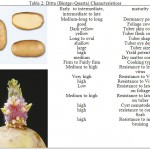 |
Table 2: Ditta (Bintge´Quarta) Characteristices.
|
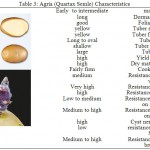 |
Table 3: Agria (Quartax Semle) Characteristics.
|
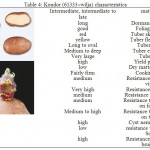 |
Table 4: Kondor (61333´wilja) characteristics.
|
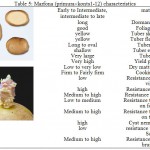 |
Table 5: Marfona (primura´konts1-12) characteristics. |
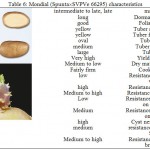 |
Table 6: Mondial (Spunta´SVPVe 66295) characteristics.
|
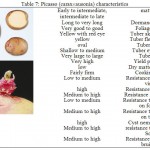 |
Table 7: Picasso (carax´ausonia) characteristics.
|
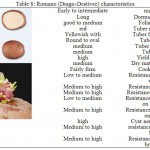 |
Table 8: Romano (Draga´Destivec) characteristics.
|
References
- Akius M and JP Kloos. 1990. Viral diseases spread and detection in Nepal. In: Proc. of 11th European Association for Potato Research (EAPR), Edinburgh. Pp. 66-67.
- Bhomi BK and JP Kloos. 1991. The seed potato programme in Nepal: Developments in a . Historic prospective. In: Proc. of the Third Triennial Conference of Asian Potato Association, Plenary papers and Abstracts, held from June 17-22, 1991. Bandung, Indonesia.
- Bisen, A.L. and A.K. Barholia. 1991. Note on performance of potato varieties during autumn crop season. Indian J. Hort. 47(1): 104-106.
- Estevez, A., J. Arzuga and S. Correa. 1982. Study of characters related to yield in potato. Cultivars Tropicales, 4(3): 549-558.
- Estevez, A. 1982. Yield performance, average tuber weight. tuber number and plant height of various potato cultivars. Cultivars Tropicales. 5(2): 279-286.
- Jablouski, K. 1990. The effect of planting depth on the yield, position of daughter tuber in the ridge and harvest parameters at inter-row spacing of 62.5 cm and 75 cm. Biuletyn instytuto Zeimniaka 36: 61-72.

This work is licensed under a Creative Commons Attribution 4.0 International License.





